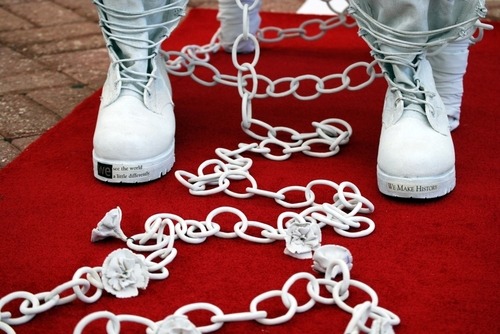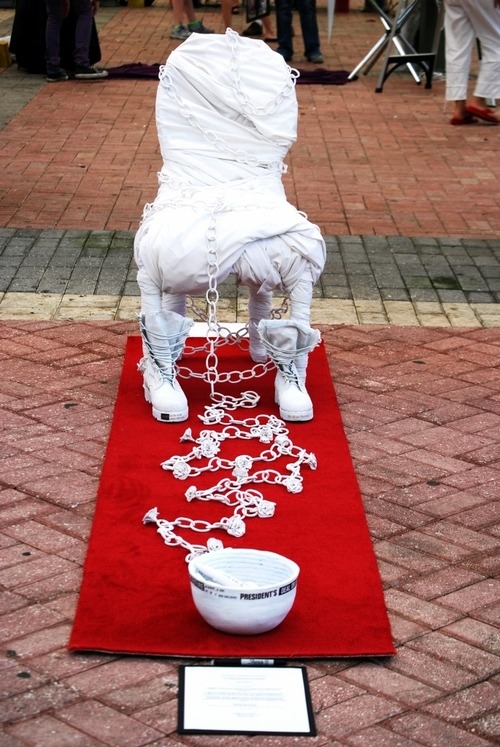
What sparked your interest for ceramics?
I was in college taking painting classes, and I wanted to learn sculpture. One day I stopped by the sculpture lab to ask the instructor if I could audit the class. She agreed and handed me a piece of clay. I was amazed at the work of the students. A retired engineer was making intriguing ceramic sculptures. The forms were powerful and provocative. At that moment, I thought of how versatile and expressive clay could be to express both powerful and delicate ideas. It was, for me, the medium of infinite possibilities.
Immediately my brain had an explosion of ideas. I fell in love. I realized I could create 3D from some ideas of my paintings. In fact, I ended up sculpting so many pieces during the class that The Art Department awarded me a grant to do a whole semester and also the first solo show ever done by a student in the college.
Besides ceramic art, you have also created paintings and murals in order to express your inner universe. How does working in three dimensions change your creative process? Do the processes differ a lot between these mediums?
When I work in 3D, the process of creativity is more fluent, very spontaneous, and I can communicate with feelings that I didn’t know I possessed until I felt them in my hands. I can transform them into something visual for others to see. It is a natural process, born of my subconscious. Back in my childhood, I recall helping my father in the garden and end up making objects with mud.
In my paintings, it’s me: my surroundings, my past and present, something very personal and intimate expressed through a different tactile experience.
As with murals, most of them have been collaborative works I’ve done with students at schools. The first one I made came out of the blue. A friend asked me for ideas on what to do with a wall where the tiles had been removed. I had the idea to teach the students about mural making and the importance of recycling material to make art. That’s how the first mural was born.
You express yourself freely using clay. What are the main materials and ceramic techniques that you use?
I like to experiment, so I have been using different kind of clay, such as stoneware, low and mid-fire with glazes and oxides. When I do mixed media, especially installations, I like to integrate other materials like metal, found objects and freshwater pearls. I use handmade techniques from slab, clay relief, and impressed texture to carving.
Your experience and your personal history seem to be an important source of inspiration for you. Tell us more about the symbolism of your work.
Maybe that’s why I work in different mediums; I am much better expressing myself visually. Sometimes an image will stay with me, and I am compelled to paint or sculpt it. Much later, I will realize that these images have a much deeper significance to me, one that transcends the visual. These images become symbols of social-political issues that are at the core of my world views and concerns. For example in the ceramic chains installation, the chains remain unconnected and loose, which symbolizes the right of freedom of the individual; regardless of religion, race, country, and gender. Freedom of expression is something that we, as humans should never have to give up.
Many of your works have an intrinsic femininity. How does being a female artist influence the themes and the ideas you choose to represent?
My themes and ideas begin with personal experiences, past, present, as well as everything that surrounds me: people, places, and objects. Sometimes stories interact with different characters in different circumstances. I also like to create surreal landscapes for them.
The white flowers I used in the “Warrior’s Series”, are images from my bank of memories of my father’s garden; he used to mix the flowers in the vegetable garden, which was my play yard during my childhood. “After Chaos,” a woman sleeps peacefully. She is able to find tranquility because she is surrounded by “white warrior flowers” – deceptively frail, and yet possessing all of the strength of memories, nature, and the power of womanhood. These flowers guard her as she rests before facing whatever trials the day may bring to her.
You come from Argentina, and you define yourself as a Latin American artist. How does your cultural heritage reflects in your creative experience?
My Latin American roots inform my work. I was born in Argentina, my parents were immigrants of the World War II, and so my background tradition at home had a strong European flavor. Even so, I grew up proud of the country that welcomed my parents and the country they taught me to love. Moreover, I am also married to a Puerto Rican man; my son was born on the island too and we spent many years there. This is yet another passage in my life, where the colors and details are reflected more in my paintings than in my ceramics. So you see, my cultural heritage is a potpourri of different tradition and experiences, and everything is reflected in my art.

Liliana Folta: An Abstract Poem of Freedom, 2009, (ongoing) traveling/interaction/installation: ceramic chain, bullets & bowl; white gesso, ink, wooden chair, white sheets, rug, soldier boots, paper, high temp wire, 3x7x2 ft.
Your interactive installation Abstract Poem of Freedom is a very complex work of art. – “An Abstract Poem of Freedom is an interactive, traveling installation, meant to honor soldiers around the world — both those who currently serve their countries and those who sacrificed their lives in any war.” What motivated you to choose this subject, and what was the feedback from the public?
My first motivation was the story of my father during War World II, a prisoner in Siberia and able to escape with his friend. It has been always in my mind and beyond my imagination. The world is constantly at war, this little tiny and beautiful blue dot in the universe.
The subject is profound, so the reaction from the public was very emotional and sensitive. Families, friends, and soldiers signed the ceramic bullets with respect and admiration for their love ones. When I visited Poland in 2011 to meet my family for the first time, I took with me a few ceramic bullets, now I have signatures from my father’s family who are survivors of war.
“An Abstract Poem of Freedom” is an interactive installation and traveling piece initiated in the island of Puerto Rico, honoring Soldiers from around the world – soldiers who have served and are still serving their own country, and the ones who sacrificed their lives in any war in history.
The continuity of the project is to call a global collaboration of artists, teachers, or anyone who is familiar with clay. If you are a ceramic teacher, your students can take part in the project. You can also help spread the word by telling your Cultural Centers, art schools etc. about the project. There are many soldiers and veterans to be honored and remembered. The collaboration consists of collecting signatures of soldier’s names to be signed on ceramic bullets. Families and friends can sign the names of those who cannot.
I believe in the power of freedom when we work united, and this is a very special project and opportunity to thank all of them – men and women – for their great courage.
I would also like to thank you in advance for giving me the opportunity to talk about the project. I wish this interactive installation can travel abroad and be presented in many places, and one day be a permanent installation. It is not meant to be kept inside a closet.
Interview by Ileana Surducan, published in Ceramics Now Magazine, Issue 2.
Visit Liliana Folta’s website.
View the list of interviews with ceramic artists.



















